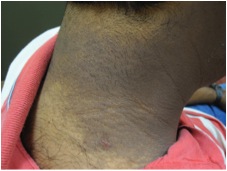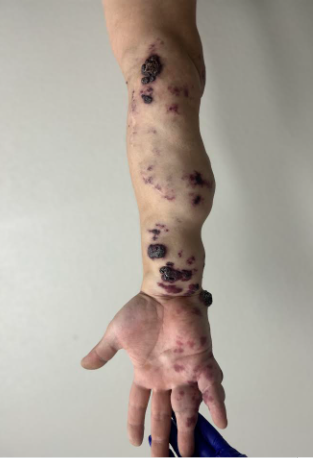CORRECT DIAGNOSIS:
Erythema dyschromicum perstans (EDP)
DISCUSSION:
EDP is a chronic acquired dermatosis of unknown etiology. Most frequently, this condition occurs in Latin Americans but it shows a predilection for skin types III-IV with an age of onset before 40. This dermatosis is asymptomatic and begins as irregularly shaped grey-blue hyperpigmented macules, sometimes with an erythematous or elevated border. These characteristic skin findings reflect the presence of melanin-laden macrophages. There is often a slow progression into symmetrical patches involving the face, neck, trunk, and/or arms with sparing of the palms and soles.
TREATMENT:
No consistently effective therapy; Small series studies: Clofazimine, Dapsone
Anecdotally: Antibiotics, Isoniazid, Griseofulvin, Antimalarials, Topical corticosteroids, Hydroquinone
REFERENCES:
Bolognia, J. L., Jorizzo, J. L., & Rapini, R. P. (2008). Dermatology (p. 941-942). Mosby.
James, W. D., Berger, T. G., & Elston, D. (2006). Andrews’ Diseases of the Skin: Clinical Dermatology (10th ed., p. 224). Saunders.
Osswald, S. S., Proffer, L. H., & Sartori, C. R. (2001). Erythema dyschromicum perstans: A case report and review. Cutis, 68, 25-28.
Wolff, K., Goldsmith, L. A., Katz, S. I., Gilchrest, B. A., Paller, A., & Leffell, D. J. (2008). Fitzpatrick’s Dermatology in General Medicine (7th ed.). McGraw-Hill.




